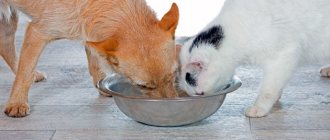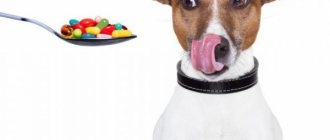How to keep your pet safe in an apartment
When leaving your dog in the apartment during hot weather, be sure to provide it with fresh air. Leave the windows open. Do not lock the interior doors - let there be more space for the four-legged to move freely around the apartment.
If the apartment is located on the sunny side, you can close the curtains a little so that the sun's rays do not heat the room. Just do not close the curtains very tightly; the tailed animal should not sit in the dark.
The doors to the bathroom can also be left open, as many shaggy cats like to lie there on the cool ceramic tiles. You can leave a damp towel on the floor. If the apartment has an air conditioner, then under no circumstances direct a stream of cold air at your pet, otherwise it may catch a cold.
How to help a dog indoors (in an apartment or house) in the heat
To help your dog and alleviate its suffering in the heat, you need to follow a few simple rules. Creating comfortable conditions will help avoid many negative consequences. You need to be especially careful with elderly and sick dogs, who tolerate elevated temperatures more difficult, and their chronic diseases may worsen. In some cases, you should contact your veterinarian for preventive and maintenance therapy.
Walks
During the hot period, it is necessary to change the walking regime. The animal is taken outside when the heat subsides - late in the evening (or at night) and early in the morning. During the day, he is walked only if absolutely necessary for 10–15 minutes, trying to stay in the shade or near open bodies of water (pond, river, zero, etc.). Walking on heated asphalt, stones, and paving stones should be avoided so that the dog does not get burnt paws.
Walking the dog is best done in the early morning or late evening hours.
It is better to postpone physical exercises with jumping and running until a cooler period, because such active exercise at elevated temperatures is extremely harmful to health and can lead to cardiac arrest.
Water balance
To maintain water balance in hot weather, a regular supply of fluid to the animal’s body is necessary. Dogs intuitively drink a lot when they are hot. Therefore, clean and fresh water should always be freely available. It is better to place additional drinking bowls where the dog prefers to be most often, and not just near the food bowl. Sterilized animals are especially sensitive to lack of fluid and dehydration, since this is fraught with the rapid development of diseases of the genitourinary system (inflammation, stone deposition, etc.).
Water needs to be changed frequently (3-4 times a day), since at high temperatures it deteriorates quite quickly . When going for a walk, you need to take a bottle with you and periodically water your pet (every half hour).
When walking, your dog needs to be given water every half hour.
The water should be cool, but not icy, otherwise your pet may get sick. For the same reason, it is not recommended to give dogs ice cream, ice, or any frozen food.
Nutrition
Most often, when it is hot, dogs refuse food or eat without much appetite. The gastrointestinal tract should not be overloaded at this time; the menu is made up of lighter and less high-calorie foods (fermented milk, vegetables, fruits, etc.). If the pet does not eat anything at all, then this is not fatal; a little starvation will not cause any harm. It is better to move feeding to a cooler time of day, that is, late evening and early morning.
Dogs often have no appetite in hot weather
With a natural diet, food left in the bowl must be removed immediately; it cannot be left for more than 30 minutes. Dry food is strictly dosed, measuring only for one meal, because granules also deteriorate (especially high-quality products that do not add heavy preservatives).
Cool corner
The animal must be able to move freely throughout all rooms to choose the most comfortable and cool place . The door to the bathroom is left open so the dog can lie on the cool tiles. You can fill the bath itself with cold water, so this small room will be a little cooler and fresher.
On the hottest summer days, our dog hid in the garage under a shelving unit, lying on the concrete floor; it was the coolest place, in her opinion. During walks she loved to swim, she could not get out of the pond at all, she would lie down in the shallow water and enjoy the coolness. Sometimes she herself asked to water her from a watering can or from a hose, eloquently pointing with her muzzle at these objects.
In hot weather, animals often lie on the cool tiled floor
Water treatments
Dogs, like people, benefit from water treatments. If your pet swims in open water during a walk, it will give him pleasure and slightly reduce his body temperature. However, a thick undercoat, if present, does not get completely wet, since it is protected by guard hair. Therefore, it is enough to simply wet the animal’s paws and head, trying to prevent water from getting into the ear canals. You can do this several times a day.
You should not pour cold water on your dog immediately after a walk, because a sudden change in temperature can lead to a cold . When bathing in the bathroom, it is better to do without detergents, but simply rinse the sufferer with lukewarm clean water.
Many dogs love to swim
You can pour some water into a large basin, where the dog will cool off whenever he wants.
Grooming
Some owners cut their dogs short, and sometimes even bald, in the summer, thinking that this will help their pets endure the heat more easily. But in fact, a haircut can do more harm than good, since the wool now does not protect the skin from the harmful effects of the sun's rays. The hairdressing procedure will only help those animals that do not have undercoat (Bichons, poodles, etc.); they are often cut, performing various model (exhibition) or hygienic (home) haircuts.
It is best to comb the undercoat thoroughly, then the dog will tolerate the heat more easily.
Dogs gifted by nature with a thick undercoat (Spitz, Husky, Samoyed, German Shepherd, etc.) cannot remove the coat, since the short downy layer retains cool air near the skin, preventing it from overheating . In addition, in some cases, hair grows back very slowly after cutting, and especially after shaving (up to 2 years). As a last resort, it can be shortened a little, but not cut to zero. A much greater effect is achieved by regular combing of the undercoat using a furminator.
Fresh air
The room should be regularly ventilated by opening windows and balcony doors wide. But you should not allow your pet to lie in a draft, because he may well catch a cold. The air conditioner or fan should be turned on carefully; the air flow should not blow directly on the dog . It is better to first cool the air in the room, and only then introduce the animal there.
Fans and air conditioners should be used carefully to prevent the dog from catching a cold.
Cloth
During hot weather, it is better to avoid clothing for dogs. The exception is animals with dark fur or bald (shaved); it is recommended to wear light, light (preferably white) shirts or T-shirts. It is also better not to use a muzzle, as it prevents the pet from cooling itself by opening its mouth and hanging its tongue.
Automobile
It is recommended to avoid long trips in hot weather . But if such a need arises, then it is better to transport the dog in the evening, when it becomes at least a little cooler. You need to take with you a supply of water and a wet towel, which is used to periodically moisten the fur (you can simply cover your pet with it).
You can't leave dogs in the car
Under no circumstances should you leave your animal in the sun in a locked car, even for a short time. The temperature in the cabin rises very quickly, the greenhouse effect (+70...+80 °C) is created within half an hour. The dog quickly dies from such overheating; open windows help little.
Cooling accessories
In specialized stores selling pet products, you can find cooling accessories:
- rugs;
- collars;
- shoes;
- headscarves;
- caps;
- bibs;
- vests;
- blankets.
The cooling effect is achieved due to the filler, which is activated by moisture (the product is soaked in water or sprayed) or by being in the cold (in the freezer, refrigerator). Particularly popular are various rugs and mattresses on which the pet can lie and spend a long time.
You can put a cooling blanket on your dog
However, cooling mats must be used with caution to prevent severe hypothermia, especially for dogs suffering from various diseases of the genitourinary system and chronic inflammation of the joints.
Video: caring for animals in the heat
Change your walking schedule
Try to walk your dog during hot weather, either early in the morning or late in the evening, when the sun's rays are no longer so scorching. If there is a need to take your pet out during the day, then try to walk with him in the shade of trees.
Keep your walk time to a minimum and be sure to take a bottle of water with you to rinse your four-legged and give him something to drink. If there are bodies of water near your house, then it is recommended to walk your dog near them in the heat. It's always cooler and fresher near the water.
How to help your pet survive the heat?
We've figured out how dogs behave in the heat, now it's important to talk about what to do or not do. First of all, there is no need to force your dog to eat or run outside.
Moreover, you should not disturb her again, just provide clean fresh water, and, if possible, create comfortable conditions at home. In any case, during the heat, you will have to follow not only a number of special rules, but also change the dog’s overall regime, feeding and care features. Let's look at them in more detail.
Daily regime
The street should not be visited during the hottest time during the day; the walk should be shifted to early morning or evening. Moreover, during this time you need to cancel all training and limit any physical activity (running, active games). In order not to overtire your pet, it is better not to walk for more than 20-30 minutes. However, if the dog drinks a lot, so as not to burden the genitourinary system, it is still advisable to take the dog outside a third time, for example, before noon.
Nutrition
Changing the feeding regime is the first action that needs to be taken during the hot period. All main food should be left for the evening, when the heat subsides. In addition, during this time you need to limit the amount of heavy food. Water should be freely available all the time, but under no circumstances should it be cold. For example, you should take water in a bottle with you outside during your walk and give your dog small portions of water as desired.
Water treatments
During the hot season, many owners notice that the dog begins to “smell” unpleasantly and try to bathe it as often as possible. But the unpleasant odor is not associated with sweating, but, as experts say, is the result of some disease or an exacerbation of a chronic illness. In this case, veterinarians do not advise resorting to frequent water procedures, since due to the washing off of the protective layer of lubricant, they can cause dermatological problems and dandruff. You need to seek help from a doctor.
Conditions in the house
Of course, the easiest way to survive the summer heat is if the conditions at home are comfortable. Then the dog will not desperately wander from corner to corner in search of the coolest place. And, of course, many owners turn on the air conditioning. But does it really save the situation and doesn’t it cause even more harm? We'll only say yes to an air conditioner if it's in another room and isn't blowing cool air directly at the animal. This means it's best to cool the room until it's comfortable, then turn off the air conditioning before letting your dog into the room.
If you can’t do this, then you need to set up a split system (dissipated flow) and set the temperature to no lower than +22 degrees. In any case, make sure that your pet does not lie on the floor under the flow of the air conditioner - this is a direct road to inflammation. When there is no air conditioning, under no circumstances should you leave the animal in a closed space. It is necessary to open the doors of adjacent rooms, as well as windows for ventilation.
Let's go on a trip with your pet
If you go on a long journey with your four-legged dog during the hot season, you must take the following measures:
- Stock up on cool water.
- Stop every 2-3 hours so the dog can drink and walk.
- Keep your dog wet with water.
- Place a wet towel on the mat to help your tail cool down.
- Remove your pet's collar.
- Do not allow your dog to stick his head out of an open window. This can not only lead to colds, but is also very dangerous for the life of the four-legged animal.
Recommendations
To help your dog survive hot days in the summer, it is enough to follow simple recommendations from veterinarians and experienced dog lovers. If you follow these tips, the summer heat will go almost unnoticed:
- in the hot season, review your walking schedule - spend more time outside early in the morning and in the evening, when the sun is not as active as during the day and the air temperature does not reach critical levels;
- active games, jogging, and sports should be postponed until cooler days or done in the evening;
- avoid long walks on concrete or asphalt surfaces, as they tend to get very hot;
- Always take clean drinking water for your pet when going for a walk;
- if the dog is kept outdoors, make sure that there is enough shade in the enclosure where the pet can hide from the sun;
- Ventilate the apartment regularly, shade windows facing the sunny side, it’s great if you have air conditioning;
- change drinking water more often than you usually do, you can put 1-2 ice cubes in a bowl;
- limit long trips as much as possible, whether by public transport or by car;
- do not leave your dog in the car, even with the windows open - the temperature in it rises at a tremendous speed and this can seriously harm the pet;
- feed little by little, without leaving food in the bowl, as in the heat it spoils very quickly and can cause poisoning;
- all procedures that may cause stress or physical tension in the animal (haircut, cleaning ears or teeth, anything that the dog does not like to do) are best postponed until a more favorable moment;
- Do not cut your dog's hair too short - this may disrupt normal natural thermoregulation and aggravate the situation.
Get out into nature more often, to bodies of water, where you can hide from the scorching rays of the sun and still have a great time with your pet.
Never leave your pet in the car
Under no circumstances should you leave your dog in the car, even if during the heat the car is in the shade and the windows are slightly open. The interior of a car is a kind of greenhouse. It heats up very quickly. If it’s +25 outside, then the temperature in the cabin is still +35. Just a couple of minutes of being in such a “greenhouse” can lead to unpredictable consequences.
If you go shopping and there is no way to take your tailed dog with you to the store, then it is better to leave it at home. Here is a table with the approximate temperature ratio between the outside and inside of the car.
Breeds at risk
Some dog breeds can tolerate heat without any problems. These are four-legged animals that have virtually no undercoat. First of all, these are Yorkies, poodles, and Irish water spaniels. Another advantage of such breeds is that they are hypoallergenic, that is, they do not cause allergies, which often occurs in owners and household members in the summer.
Dogs with black short hair do not tolerate seasonal increases in temperature: Great Danes, Rottweilers, Dobermans, as well as dogs with a shortened skull - pugs and bulldogs - as it heats up faster.
Huskies can stay in the heat for no more than an hour
But the worst conditions in the heat are Caucasian and Central Asian shepherd dogs, huskies and huskies. Representatives of these breeds are either not genetically accustomed to heat, since they historically lived in cold conditions, or they have thick wool, more reminiscent of a fur coat. You won’t last long in such “clothes” under the scorching sun.
Do not put a tight muzzle on your four-legged animal.
Don't put a tight muzzle on your dog when it's hot. The thermoregulation mechanism of a quadruped is designed so that cooling occurs through the nose, tongue (frequent breathing and intense salivation) and paw pads.
Therefore, a dog “shackled” in a tight muzzle, unable to breathe intensively, sticking out its tongue, may die from overheating.
If your pet must be muzzled, then do not tighten it too much. And every 10 minutes, remove it to allow the tailed one to breathe and drink water.
Urgent Care
Most often, the pet copes with the first stage of overheating on its own, the main thing is not to disturb it. If your dog shows signs of illness, do the following:
Move the animal to a cool room - temperature 18–22 C°, the floor surface is cold (remove carpets), a drinking bowl with cool, clean water is brought into the room, if there is no draft, wipe the dog’s fur with a wet towel.
Make sure your dog drinks in doses.
Place a cold alcohol compress or ice wrapped in film and thin cloth on the forehead, armpits and thighs.
If the dog has short hair, rub the pulse points and back with ammonia (medicinal alcohol will also work); with long hair, treat all exposed areas of the body. Use cotton wool soaked in alcohol, making sure that the dog does not bury its nose or lick the smeared area.
If there is no air conditioning, cover the dog with a damp sheet (not completely) and direct the air flow from the fan at it - take breaks in the blowing every 7-10 minutes.
Constantly monitor your body temperature using a thermometer (preferably an electronic one) - it is important to “lower” the temperature gradually, allowing 1–1.5 hours to cool down. Do not overdo it, at a temperature of 39.5 the active cooling process must be stopped
If you find a dog in serious condition, medical first aid for heatstroke is carried out:
Giving your dog an enema with water at room temperature is an unpleasant procedure, but it effectively cools the internal organs.
With hypothermia, there is a high risk of developing heart failure - shortness of breath and cyanosis appear - take sulfocamphocaine intramuscularly. Based on the weight of the dog, it is calculated how much sulfocamphocaine to inject; for dogs up to 40 kg - 1 cube, over - 2 cubes.
A drug that may not be at hand, but should be in the first aid kit if your dog is prone to heatstroke - Belladonna-Homaccord or an analogue - used by injection (intravenously or subcutaneously) or dripped onto the oral mucosa - 5 drops every 10 minutes until the heart rate returns to normal rhythm.
To raise the tone of the body, intramuscularly Gamavit or an analogue, 2.5 ml for small breeds, 5 ml for large breeds.
https://youtube.com/watch?v=fXQ4PCNsFS4
For convulsions, loss of consciousness and more serious symptoms, “home” treatment is practically powerless; intravenous injections and infusions, detoxification, blood thinning, and kidney and heart support are needed. Every minute counts, so take your dog to the veterinary hospital right away. A veterinarian who visits a home does not always cope with the “scale of events.”
Take care of your paw pads
Try not to walk your dog on hot asphalt. Your pet may simply burn his paw pads. The same rule applies on a sandy or pebble beach.
If you yourself are not able to walk through the hot sand barefoot, then your tailed dog may also get burns on its pads. Walk your dog in the shade, or best of all, on the grass.
Is it possible to walk your dog in hot weather?
Many dogs in the summer prefer to sleep on the cool floor of the house rather than walk under the scorching rays of the sun, but walks should not be completely eliminated - the dog must move and breathe fresh air. During periods of abnormal heat, it is preferable to walk early in the morning and in the evening, and during the daytime, take the animal out only to relieve itself (for 15-20 minutes). If you do have to leave the house with your dog for a long time, be sure to take a bottle of water for a walk to periodically wet your pet’s belly and thighs. While walking, offer your dog a drink (every 30 minutes, but in small portions).
Keep an eye on your pet's hair
There is an opinion that in hot weather it is necessary to cut your dog's hair shorter. This is a wrong opinion, you can’t do that. If the fur is very short, then the tailed dog can receive extensive burns throughout the body. Sufficiently long hair creates an air layer that prevents the animal from overheating.
Also, extreme heat can cause shedding. Therefore, do not forget to comb your pet and treat it for fleas and ticks. After all, scratching after bites of these insects is very difficult to heal in the heat and can cause infections.
How do dogs behave in the heat?
The process of thermoregulation in dogs works differently than in humans. Sweat is secreted through special eccrine glands located on the soft parts of the paws. However, the area of the pads is small and they play a minor role in the cooling process of the body. Rapid breathing with an open mouth and protruding tongue helps the animal get rid of excess heat, while intense evaporation of moisture occurs from the mucous membranes of the nasal and oral cavities.
The thick, dense undercoat protects not only from cold, but also keeps cool in hot weather.
When a dog is hot, it tries to move as little as possible, preferring to sleep in a secluded and as cool as possible corner (for example, on a tiled floor in a bathroom). The pet is usually lethargic, inactive, his appetite completely disappears, and he refuses to eat. Elevated temperature has a relaxing effect on him. Food can spoil in the heat, and the animal will no longer eat it. It is for this reason that dogs experience digestive system disorders (diarrhea and nausea) caused by pathogenic bacteria that have developed in the food.
In hot weather, dogs try to lie down in the coolest place, for example, on cold stone steps
Since a lot of fluid is used to cool the body, in order to maintain water balance, the dog needs to increase its consumption - he drinks more water, and reduce its consumption - he pees less. If an animal refuses to drink, this is extremely dangerous, as it can lead to severe dehydration . The reason for the refusal may be the poor quality of the water poured into the bowl (it has spoiled, smells of detergent, etc.). A dog's dry and warm nose usually indicates the onset of dehydration.
If the pet is too lethargic and apathetic, breathes very heavily and frequently (sometimes whines), does not react to others, has poor spatial orientation, has a rapid heartbeat and convulsions, then it needs urgent help.
Video: Heat stroke in a dog
How to cool a four-legged animal
You can cool your dog during the heat in the following ways:
- Wet your four-legged head, paws (especially pads), belly, ears and nose, groin area and armpits with cool (not ice) water.
- At home, you can fill the bathtub with water and put the tailed one in there.
- After taking a bath, do not wipe the furry one dry, let it remain a little damp.
- Take walks near bodies of water more often and let your fidget swim.
- If the dog is not a fan of swimming, then you can simply spray it with a spray bottle.
Feeding
Some dogs in the summer, when it is especially hot, refuse food themselves. Do not force your pet to eat by offering him the most delicious pieces, because if the refusal to eat is associated with heat, there is nothing dangerous in such a “hunger strike”. But the so-called “food eaters” are ready to eat around the clock, even in the hottest season - the owner should reduce the portion for such dogs.
In hot weather, it is best to feed the dog twice a day in small portions - in the morning light foods, milk, eggs, vegetables and fruit, and in the evening - lean meat or fish. If the dog eats dry food, the bowl should only contain a daily portion - do not pour a full bowl of food, since at high air temperatures the fats included in high-quality dog food (without heavy preservatives) quickly deteriorate.
In hot weather, water should be placed not only near the feeding area, but also where the dog spends the most time (for example, in the master bedroom). Having fallen asleep, the dog may overheat, and when it wakes up, it simply does not have enough strength and desire to walk across the entire apartment to a bowl of water. In summer, water needs to be changed several times a day - in hot weather, dogs drink cool, fresh water with greater pleasure than warm water with pathogenic bacteria actively multiplying in it.
Recommendations for street dogs
If your pet does not live in an apartment, but in a kennel on the street, you should make sure that its house is in a shaded, cool place. It can stand under a tree or under a canopy.
If this is not possible, then take the four-legged one indoors during the hottest period. Never tether your dog in the hot sun.
Do not forget to provide the tailed one with the necessary amount of water. You can even deploy an inflatable pool so that your furry one can cool off there.
Conditions in the house
A system of measures to lower the temperature must be organized in the room. It’s worth thinking about how to cool your dog down in the heat at home in advance, since the slightest delay can lead to disaster.
More fresh air
What to do if your dog is hot in the apartment in summer? First of all, it is necessary to regularly ventilate the room. Just ventilate, not keep the windows open. If the windows are open all the time, the temperature in the apartment gradually approaches the temperature outside. It is much easier to maintain a low temperature in a room if you ventilate all rooms for 10-15 minutes every 2-3 hours. The stagnant air will be replaced, and the temperature will be comfortable.
Air conditioning - friend or foe
When wondering how to cool a dog in extreme heat, the first thing many people think of is air conditioning. You can and even need to use it, but you should pay attention to some nuances.
Important! The danger lies precisely in the direct strong flow of cold air onto the heated body of the animal. This can lead to colds or inflammation of internal organs.
The best option is to install the air conditioner or fan so that it blows on the furniture or ceiling, and not on the animal. It is worth remembering that the main task is to lower the temperature in the house, and not to cool the body. If your dog breathes frequently in hot weather, you can put him in a room with air conditioning.
What to do if your dog gets heatstroke
See what symptoms of heat stroke your dog may be experiencing and what steps to take as soon as possible.
Symptoms of overheating or heatstroke
You will be able to observe the following:
- Rapid breathing.
- Dry nose.
- Profuse salivation.
- Burgundy or blue swelling of the mucous membrane of the mouth and tongue.
- Cloudy or red eyes.
- Disorientation, staggering gait, lethargy.
- Diarrhea or vomiting.
- Weak pulse.
- Increased body temperature.
- Loss of consciousness.
What measures need to be taken urgently
If a dog suffers from heatstroke, then it is necessary to reduce the pet’s body temperature as quickly as possible (normal body temperature is 39-39.5 degrees).
And to do this you need to do the following:
- Take the animal to a cool, shaded area.
- Try to provide access to fresh air. If there is no fan nearby, then simply fan the four-legged animal with newspaper.
- Rinse the tailed one with water at room temperature (but never cold, to avoid a sharp drop in temperature, which can cause cardiac arrest).
- Wrap your dog in a damp towel.
- Monitor your body temperature regularly (rectally). As soon as it reaches the norm, immediately stop all cooling measures, wipe the dog dry and give it a drink of water.
- To avoid complications, take your pet to a veterinary clinic.
Knowing all these simple rules, you can easily protect your dog in the heat without bringing your furry pet to heatstroke.
First aid for overheating pet
If overheating cannot be avoided, the animal needs to be helped immediately. All actions must be performed strictly according to the rules, so as not to aggravate the animal’s condition and avoid negative consequences.
Actions to take immediately
When signs of heat stroke appear, the main task is to reduce the temperature to +39...+39.5 °C. You need to deal with this in the next half hour.
First aid is provided according to the following scheme:
Move your pet to a fairly cool place.- Place the animal so that its head is slightly lower than its body.
- Wet your pet's fur with cool water. It is strictly prohibited to use ice and cold liquid for this purpose, otherwise the vessels will reflexively narrow and heat transfer will be difficult.
- Provide fresh air flow.
- Place a wet towel on the dog's head.
- Wet the mouth with water using a spray bottle.
- Apply cold compresses to the thighs and armpits.
- Constantly monitor the animal's temperature. It must be measured rectally. Cooling is stopped when the thermometer reaches +39 °C.
After this you need to contact a veterinarian. The doctor will prescribe further treatment. If this is not possible, you can give an enema filled with cool water.
Such actions help reduce the temperature of internal organs. Intramuscular administration of Sulfocamphocaine is also allowed. This drug stimulates the activity of the heart.
Antipyretic drugs
In order to reduce body temperature, it is allowed to use antipyretic drugs.
They should be ground into powder and added to water. Give your pet the resulting solution.
Care after heatstroke
After the blow, the dog needs to be properly cared for. Tips to follow:
provide free access to water to restore water balance;- adjust your diet (exclude heavy, fatty foods from the menu);
- avoid excessive physical exertion, overheating and hypothermia;
- place the animal in a cool place.
Dog body temperature.
One of the most important indicators of a dog's health is body temperature. Hot weather is one of the factors that causes a change in the temperature of an animal. Thus, an increase of 0.5-1 °C is considered normal temperature for dogs in the heat. If the increase is short-term, then there is no reason to worry. You just need to reduce the environmental impact on your pet (we will talk about this below). But a significant long-term deviation requires you to immediately show your dog to a veterinarian.
There is no single temperature indicator for all dogs. The temperature of four-legged friends depends on the breed, age, physical condition, weight, etc. For example, for representatives of decorative breeds, the temperature at which large animals are already taken to the veterinarian is considered normal. For convenience, we provide a table of average body temperatures depending on the age and size of the dog.
Average body temperatures of dogs depending on age and size.
| Dog breeds | Temperature, °C |
| Small | |
| - puppy | 38,5-39,3 |
| - adult | 38,5-39,0 |
| Average | |
| - puppy | 38,5-39,0 |
| - adult | 37,5-39,0 |
| Large | |
| - puppy | 38,0-39,0 |
| - adult | 37,5-38,5 |
But do not forget about the individual characteristics of pets associated, for example, with physical activity, stressful situations, childbirth or estrus.










